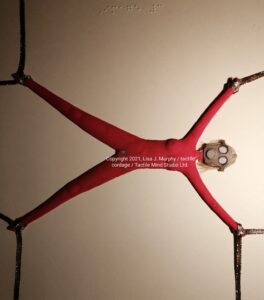

Just a couple pictures of me (Lisa J. Murphy) pressing pages of tactile mind at home. For those who have a vision impairment or blindness, or anyone who is simply curious; I will give you a quick description. In the two pictures, I am putting the master copy Braille page of Diagram 13/ Bullet Belt onto the thermoform machine. I am laying the page within the confines of the machine; the base and frame of the thermoform machine is layered in tape to get the best suction. Soon I lay a piece of thermoform plastic on top, press the edges down with the frame, pull the heat source over the diagram and the plastic, the vacuum suction goes – and voila! A 3-D thermoform diagram page.
Sounds really easy. In reality many things can go wrong. The diagram, for starters can break – but that is the worst case scenario. Lately, I’ve had a couple problems in my master pages with a knee cap dislodging , a couple nipples coming loose, a background shredding, hearts moving, and a vagina crumbling. Nothing major, very fixable – just general wear and tear on the images.
Also, my trusty thermoform machine can be a little tempermental. I just give her lots of time to heat up, and some break periods throughout days when I’m printing.



